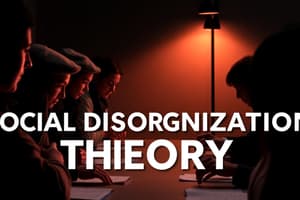Podcast
Questions and Answers
What is the primary focus of zemiology, as opposed to traditional criminology?
What is the primary focus of zemiology, as opposed to traditional criminology?
- Analyzing the economic costs of crime
- Examining the legal definitions of crime as given
- Focusing on individual criminal behavior and motivations
- Investigating social harm rather than just legally defined crimes (correct)
Which of the following best describes the 'ontological reality of crime' according to the text?
Which of the following best describes the 'ontological reality of crime' according to the text?
- Crime is an intrinsic behavior that is universally recognized
- Crime is an objective measure of antisocial behavior
- Crime is a social construct defined by legal systems and social relations (correct)
- Crime is determined by an individual's moral choices only
What does the 'myth of crime' refer to in the context of the excerpt?
What does the 'myth of crime' refer to in the context of the excerpt?
- The fictional elements often depicted in crime novels
- The common misconceptions about crime rates and victim statistics
- The acceptance of crime as a self-evident concept without questioning its definitions (correct)
- The idea that crime only affects certain segments of the population
What is a critique of the criminal justice system's approach to crime?
What is a critique of the criminal justice system's approach to crime?
Which of the provided examples illustrates how the same act can be defined differently based on legal and social contexts?
Which of the provided examples illustrates how the same act can be defined differently based on legal and social contexts?
What does the text suggest about the effectiveness of current crime control measures?
What does the text suggest about the effectiveness of current crime control measures?
Which statement most accurately summarizes the text's view on the criminalization process?
Which statement most accurately summarizes the text's view on the criminalization process?
The text advocates for a broader understanding of harm by calling for an interdisciplinary approach. Which of these is an example of an area beyond criminology that this approach might include?
The text advocates for a broader understanding of harm by calling for an interdisciplinary approach. Which of these is an example of an area beyond criminology that this approach might include?
Which factor most significantly complicates detainees' agency within detention centers?
Which factor most significantly complicates detainees' agency within detention centers?
How does the text describe the moral and normative space occupied by detention centers?
How does the text describe the moral and normative space occupied by detention centers?
Which aspect of a detainee's identity is noted as being crucial in determining their experiences within detention centers?
Which aspect of a detainee's identity is noted as being crucial in determining their experiences within detention centers?
What distinguishes detention centers from prisons, according to the text?
What distinguishes detention centers from prisons, according to the text?
Why is the concept of agency described as 'problematic' in the context of detention centers?
Why is the concept of agency described as 'problematic' in the context of detention centers?
What is meant by the critique that detention centers employ a 'one-size-fits-all' approach?
What is meant by the critique that detention centers employ a 'one-size-fits-all' approach?
What is a key ethical concern associated with the increased militarization of border enforcement?
What is a key ethical concern associated with the increased militarization of border enforcement?
Why does the text emphasize the difference between 'agency' and 'compliance' in the context of detention?
Why does the text emphasize the difference between 'agency' and 'compliance' in the context of detention?
How does the sharing of biometric data across nations impact individuals?
How does the sharing of biometric data across nations impact individuals?
What is a key moral imperative related to addressing immigration detention?
What is a key moral imperative related to addressing immigration detention?
What concept reflects systemic inequalities where marginalized populations, especially migrants, disproportionately face punitive measures?
What concept reflects systemic inequalities where marginalized populations, especially migrants, disproportionately face punitive measures?
What is the intrinsic nature of punishment as it relates to the state?
What is the intrinsic nature of punishment as it relates to the state?
What does 'Withdrawal of Rights' specifically entail for irregular migrants?
What does 'Withdrawal of Rights' specifically entail for irregular migrants?
How does the text describe the harms suffered by migrants at borders as a result of securitization?
How does the text describe the harms suffered by migrants at borders as a result of securitization?
What comparison does the text make regarding migration control and its impact on marginalized groups?
What comparison does the text make regarding migration control and its impact on marginalized groups?
What is a key recommendation for re-evaluating current approaches to migration and crime control?
What is a key recommendation for re-evaluating current approaches to migration and crime control?
What is the primary concern that wealthy nations exhibit in response to global population pressures, economic crises, and shifting political power?
What is the primary concern that wealthy nations exhibit in response to global population pressures, economic crises, and shifting political power?
What does the term 'criminology of mobility' refer to?
What does the term 'criminology of mobility' refer to?
How does the text define 'criminalization' in the context of border control and migration?
How does the text define 'criminalization' in the context of border control and migration?
What is the relationship between migration control and crime control systems, as described in the text?
What is the relationship between migration control and crime control systems, as described in the text?
What is 'crimmigration law'?
What is 'crimmigration law'?
What is the text’s view on the concept of border crossing in relation to criminality?
What is the text’s view on the concept of border crossing in relation to criminality?
Which of the following best describes the discourse around migration as discussed in the text?
Which of the following best describes the discourse around migration as discussed in the text?
What phenomenon is highlighted by the observation of stricter border policies and their impact on marginalized groups?
What phenomenon is highlighted by the observation of stricter border policies and their impact on marginalized groups?
What is the primary ethical concern regarding the designation of 'safe third countries' for asylum seekers?
What is the primary ethical concern regarding the designation of 'safe third countries' for asylum seekers?
How does the EU's externalization strategy impact its obligations under international law?
How does the EU's externalization strategy impact its obligations under international law?
What role do financial incentives play in the EU's migration policies?
What role do financial incentives play in the EU's migration policies?
What is a major consequence of the EU's strategy to use third countries as 'containment zones'?
What is a major consequence of the EU's strategy to use third countries as 'containment zones'?
How does the framework of externalization affect the rights of migrants?
How does the framework of externalization affect the rights of migrants?
What legal principle is put at risk by the transfer of asylum responsibilities to third countries?
What legal principle is put at risk by the transfer of asylum responsibilities to third countries?
What can be inferred about the future of asylum policies based on current trends in externalization?
What can be inferred about the future of asylum policies based on current trends in externalization?
In what way do the Italy-Libya cooperation programs exemplify the criticisms of externalization?
In what way do the Italy-Libya cooperation programs exemplify the criticisms of externalization?
What is one primary aim of the EU's externalization policies as discussed?
What is one primary aim of the EU's externalization policies as discussed?
What potential consequence of the UK's Rwanda model is highlighted?
What potential consequence of the UK's Rwanda model is highlighted?
Critics of the EU's externalization strategies argue that these policies reflect a desire to do what?
Critics of the EU's externalization strategies argue that these policies reflect a desire to do what?
How are the externalization policies characterized in relation to EU's commitment to international law?
How are the externalization policies characterized in relation to EU's commitment to international law?
What is a significant underlying aim of externalization policies when it comes to migration?
What is a significant underlying aim of externalization policies when it comes to migration?
Which of these deals exemplifies the externalization strategy within the EU?
Which of these deals exemplifies the externalization strategy within the EU?
What is the intended effect of creating distance between migrants and EU borders, as per the externalization policies?
What is the intended effect of creating distance between migrants and EU borders, as per the externalization policies?
How can the EU's approach to asylum seekers be characterized according to the described policies?
How can the EU's approach to asylum seekers be characterized according to the described policies?
Flashcards
Crimmigration law
Crimmigration law
The convergence of immigration and criminal law that treats border violations as criminal offenses.
Criminalization of mobility
Criminalization of mobility
The process by which border crossing is labeled as a criminal act due to societal definitions and power dynamics.
Global apartheid
Global apartheid
A systematic divide between wealthy and impoverished nations, intensifying through immigration policies.
Surveillance in migration control
Surveillance in migration control
Signup and view all the flashcards
Migration-control industry
Migration-control industry
Signup and view all the flashcards
Criminology of mobility
Criminology of mobility
Signup and view all the flashcards
Punitive migration policies
Punitive migration policies
Signup and view all the flashcards
Ethnocultural diversity
Ethnocultural diversity
Signup and view all the flashcards
Externalization Policies
Externalization Policies
Signup and view all the flashcards
Control Over Compassion
Control Over Compassion
Signup and view all the flashcards
UK-Rwanda Model
UK-Rwanda Model
Signup and view all the flashcards
Deterrence Strategy
Deterrence Strategy
Signup and view all the flashcards
Integrity of Humanitarian Principles
Integrity of Humanitarian Principles
Signup and view all the flashcards
Psychological Distance
Psychological Distance
Signup and view all the flashcards
Migration System Based on Fairness
Migration System Based on Fairness
Signup and view all the flashcards
Partnership vs Containment
Partnership vs Containment
Signup and view all the flashcards
Zemiology
Zemiology
Signup and view all the flashcards
Social Harm
Social Harm
Signup and view all the flashcards
Crime Variation
Crime Variation
Signup and view all the flashcards
Constructed Concept of Crime
Constructed Concept of Crime
Signup and view all the flashcards
Myth of Crime
Myth of Crime
Signup and view all the flashcards
Exclusion of Serious Harms
Exclusion of Serious Harms
Signup and view all the flashcards
Criminalization Process
Criminalization Process
Signup and view all the flashcards
Ineffectiveness of Crime Control
Ineffectiveness of Crime Control
Signup and view all the flashcards
State Power in Detention
State Power in Detention
Signup and view all the flashcards
Detainee Identity
Detainee Identity
Signup and view all the flashcards
Racial and Gender Bias
Racial and Gender Bias
Signup and view all the flashcards
Agency vs. Compliance
Agency vs. Compliance
Signup and view all the flashcards
Moral Gray Area
Moral Gray Area
Signup and view all the flashcards
Indefinite Detention
Indefinite Detention
Signup and view all the flashcards
Intersectionality
Intersectionality
Signup and view all the flashcards
Globalization and Mobility
Globalization and Mobility
Signup and view all the flashcards
Asylum Protections
Asylum Protections
Signup and view all the flashcards
Safe Third Countries
Safe Third Countries
Signup and view all the flashcards
Non-refoulement
Non-refoulement
Signup and view all the flashcards
Externalization of Asylum
Externalization of Asylum
Signup and view all the flashcards
EU's Role
EU's Role
Signup and view all the flashcards
Migration Control
Migration Control
Signup and view all the flashcards
Ethical Implications
Ethical Implications
Signup and view all the flashcards
Containment Zones
Containment Zones
Signup and view all the flashcards
Crimmigration
Crimmigration
Signup and view all the flashcards
Militarization of Borders
Militarization of Borders
Signup and view all the flashcards
Immacroceration
Immacroceration
Signup and view all the flashcards
Biometric Data Sharing
Biometric Data Sharing
Signup and view all the flashcards
Withdrawal of Rights
Withdrawal of Rights
Signup and view all the flashcards
Deaths at Borders
Deaths at Borders
Signup and view all the flashcards
Economic and Racial Inequality
Economic and Racial Inequality
Signup and view all the flashcards
Ethical Concerns of Force
Ethical Concerns of Force
Signup and view all the flashcards
Study Notes
Criminology-crime:
- Criminology is a comprehensive overview of the field, exploring its complexities.
- Crime is viewed as a form of social production, creating various professions, including criminologists.
- Criminology is a political endeavor, influenced by who defines crime and who receives punishment.
- Sutherland's definition of criminology encompasses law-making, law-breaking, and societal reactions.
- Criminology evolved from disparate interests into a recognized field, drawing from disciplines like sociology, psychology, and law.
- Criminology isn't a single theoretical framework, featuring various perspectives.
- Common misconceptions include the belief that criminologists investigate crime directly.
- Core questions of criminology revolve around definition, perpetrators, and societal responses.
- Cultural contexts influence criminal behavior, as acts like graffiti have different meanings.
Historical Changes in Legality:
- Legal definitions and criminal acts have changed over time, influenced by social movements.
- The text uses the Loving case example to illustrate changes in marriage laws, impacting social movements.
- Activities that were once tolerated (e.g., drug use) have been criminalized.
Relativity Across Jurisdictions:
- Criminal definitions vary between cultures and legal systems
- Different cultures and legal systems treat similar actions differently.
- Different treatment for children and juveniles in the legal system is explained.
Social Construction of Crime:
- Criminal behavior is defined by societal constructs and power structures, benefiting specific groups.
- Power disparities affect criminal justice actions, and corporate wrongdoing is sometimes overlooked.
Crime vs Harm:
- Crime is multifaceted, encompassing a wide range of behaviors, not all of which have common characteristics.
- Behaviors like drink driving, prostitution, and identity theft, although crimes, vary significantly in context and impact.
Criminals as a Category:
- The term "criminal" implies uniformity of characteristics, which isn't accurate.
- Many individuals in the U.S. have criminal records, but this doesn't imply inherent characteristics.
- Factors such as family violence, substance abuse during childhood, and other factors, are linked to criminal behavior.
The Nature of Harm and Criminal Justice:
- Offenses may cause limited harm, which raises questions about the goals of the criminal justice system.
- Significant harms, including those caused by governments and corporations, are sometimes overlooked.
- Traditional justice may fall short of resolving conflicts, requiring evaluation of alternative methods.
Zemiology:
- Zemiology suggests a focus on social harm, encompassing a wider understanding of harm.
- Challenges traditional definitions of crime to include broader issues of harm.
Ontological Reality of Crime:
- Criminology needs to consider the constructed nature of crime and that it does not inherently exist.
- Legal systems define crime based on social considerations, making it contingent.
- Perceptions of crime vary across contexts and times, causing inconsistencies in the definition.
Critiques of Crime as a Concept:
- Criminology frequently fails to adequately consider the broader harms caused by powerful entities.
- Focusing on crime as a singular category ignores numerous instances of harmful actions.
Harms of the Criminal Justice System:
- The harms of the criminal justice system itself are discussed.
- Punitive measures and their consequences for communities are analyzed.
Expanding Definitions of Harm:
- The definition of crime should be extended beyond legal violations to include social and moral considerations.
Zemiology as a Discipline:
- Zemiology as a discipline focuses on social harm.
- This includes analyzing the relationships between social harm, power imbalances, and systemic inequality.
Mobility Inequality:
- Global mobility is unequally distributed, creating a divide between tourists and vagabonds.
- Vagabonds, often from the global south, face greater challenges in accessing opportunities for mobility.
Fluid vs Solid borders:
- Borders have become more fluid, with various physical and virtual restrictions influencing migration
- Physical and virtual borders are discussed and their significance on social exclusion highlighted.
Knowledge Production and Global Inequality:
- Global North-centric views of criminology must be challenged to incorporate global south perspectives.
- Criminological insights from Global South societies are crucial for a more complete understanding of crime.
- The global south comprises approximately 85% of the world's population.
Southern Criminology:
- Southern Criminology seeks to incorporate the unique experiences of the global South.
- This approach critiques North-centric criminology, advocating for more comprehensive perspectives.
- Critical examination of colonialism and global power dynamics is crucial for understanding crime.
- The unique historical contexts and perspectives of the Global South are essential to understand crime.
Harms of the Criminal Justice System:
- The system's inherent harms include legal pollution and the negative effects of punitive measures.
- The shortcomings of relying solely on punitive measures are highlighted.
Expanding Definitions of Harm:
- The concept of "harm" should also encompass actions not explicitly deemed criminal but with significant societal consequences
The Criminilization of Mobility:
- The concept of crimmigration law is introduced.
- How border control relates to and impacts migration.
- How migration control technologies are evolving.
Critiques of Traditional Criminology:
- Traditional criminology often fails to adequately capture the complex and nuanced aspects of crime and its context.
Moral Underpinnings of Punishment:
- Moral imperatives to understand punishment in the context of crime, particularly concerning non-citizens
State-Sponsored Discrimination and the Treatment of Refugees:
- State-sponsored discrimination against migrants and refugees is deeply embedded in Turkey.
The Case of "Festus Okey"
- The case exemplifies the pervasiveness of impunity surrounding state-sanctioned violence against migrants.
Studying That Suits You
Use AI to generate personalized quizzes and flashcards to suit your learning preferences.





